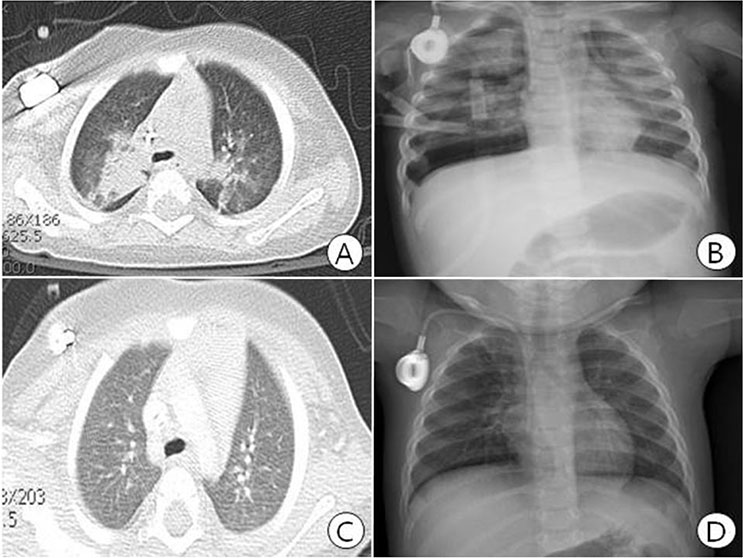Korean J Pediatr Infect Dis.
2012 Dec;19(3):162-167.
A Case of Therapy of Aerosolized Ribavirin in a Leukemia Infant with RSV Infection
- Affiliations
-
- 1Department of Pediatrics, College of Medicine, Korea University, Seoul, Korea.
- 2Department of Pediatrics, College of Medicine, The Catholic University of Korea, Seoul, Korea. kjhan@catholic.ac.kr
Abstract
- Respiratory syncytial virus (RSV) is the major cause of lower respiratory tract infection in infants. Life-threatening RSV infection is often reported in young children and immunocompromised hosts. Since there is no report on ribavirin therapy for RSV pneumonia in pediatric cancer patients in Korea, we report one case of RSV pneumonia that developed in an infant with acute lymphoblastic leukemia (ALL). Despite administration of oral ribavirin and intravenous immunoglobulin, the patient's respiratory distress worsened and admission to an intensive care unit was necessary. Chest x-ray showed multifocal consolidation, pneumothorax, and pneumomediastinum. Treatment with aerosolized ribavirin led to significant clinical improvement. The role of aerosolized ribavirin is still controversial, but it might have a therapeutic potential for severe RSV pneumonia in children with leukemia.
Keyword
MeSH Terms
Figure
Reference
-
1. Wright M, Piedimonte G. Respiratory syncytial virus prevention and therapy: past, present, and future. Pediatr Pulmonol. 2011. 46:324–347.
Article2. Law BJ, Carbonell-Estrany X, Simoes EA. An update on respiratory syncytial virus epidemiology: a developed country perspective. Respir Med. 2002. 96:Suppl B. S1–S7.
Article3. Welliver RC. Review of epidemiology and clinical risk factors for severe respiratory syncytial virus (RSV) infection. J Pediatr. 2003. 143:S112–S117.
Article4. De Pauw B, Walsh TJ, Donnelly JP, Stevens DA, Edwards JE, Calandra T, et al. Revised definitions of invasive fungal disease from the European Organization for Research and Treatment of Cancer/Invasive Fungal Infections Cooperative Group and the National Institute of Allergy and Infectious Diseases Mycoses Study Group (EORTC/MSG) Consensus Group. Clin Infect Dis. 2008. 46:1813–1821.5. Harrington RD, Hooton TM, Hackman RC, Storch GA, Osborne B, Gleaves CA, et al. An outbreak of respiratory syncytial virus in a bone marrow transplant center. J Infect Dis. 1992. 165:987–993.6. Torres HA, Aguilera EA, Mattiuzzi GN, Cabanillas ME, Rohatgi N, Sepulveda CA, et al. Characteristics and outcome of respiratory syncytial virus infection in patients with leukemia. Haematologica. 2007. 92:1216–1223.
Article7. Hall CB, Powell KR, MacDonald NE, Gala CL, Menegus ME, Suffin SC, et al. Respiratory syncytial viral infection in children with compromised immune function. N Engl J Med. 1986. 315:77–81.
Article8. El Saleeby CM, Somes GW, DeVincenzo JP, Gaur AH. Risk factors for severe respiratory syncytial virus disease in children with cancer: the importance of lymphopenia and young age. Pediatrics. 2008. 121:235–243.
Article9. Raboni SM, Nogueira MB, Tsuchiya LR, Takahashi GA, Pereira LA, Pasquini R, et al. Respiratory tract viral infections in bone marrow transplant patients. Transplantation. 2003. 76:142–146.
Article10. Groothuis JR, Woodin KA, Katz R, Robertson AD, McBride JT, Hall CB, et al. Early ribavirin treatment of respiratory syncytial viral infection in high-risk children. J Pediatr. 1990. 117:792–798.
Article11. Hall CB, McBride JT, Walsh EE, Bell DM, Gala CL, Hildreth S, et al. Aerosolized ribavirin treatment of infants with respiratory syncytial viral infection. A randomized double-blind study. N Engl J Med. 1983. 308:1443–1447.
Article12. Shults RA, Baron S, Decker J, Deitchman SD, Connor JD. Health care worker exposure to aerosolized ribavirin: biological and air monitoring. J Occup Environ Med. 1996. 38:257–263.
Article13. Anak S, Atay D, Unuvar A, Garipardic M, Agaoglu L, Ozturk G, et al. Respiratory syncytial virus infection out-break among pediatric patients with oncologic diseases and/or BMT. Pediatr Pulmonol. 2010. 45:307–311.
Article14. Raza K, Ismailjee SB, Crespo M, Studer SM, Sanghavi S, Paterson DL, et al. Successful outcome of human metapneumovirus (hMPV) pneumonia in a lung transplant recipient treated with intravenous ribavirin. J Heart Lung Transplant. 2007. 26:862–864.15. Sparrelid E, Ljungman P, Ekelöf-Andström E, Aschan J, Ringdén O, Winiarski J, et al. Ribavirin therapy in bone marrow transplant recipients with viral respiratory tract infections. Bone Marrow Transplant. 1997. 19:905–908.16. Hasejima N, Yamato K, Takezawa S, Kobayashi H, Kadoyama C. Invasive pulmonary aspergillosis associated with influenza B. Respirology. 2005. 10:116–119.
Article17. Alba D, Gomez-Cerezo J, Cobo J, Ripoll MM, Molina F, Vazquez JJ. Invasive pulmonary aspergillosis associated with influenza virus. An Med Interna. 1996. 13:34–36.
Article18. Marr KA, Carter RA, Boeckh M, Martin P, Corey L. Invasive aspergillosis in allogeneic stem cell transplant recipients: changes in epidemiology and risk factors. Blood. 2002. 100:4358–4366.
Article19. Martino R, Piñana JL, Parody R, Valcarcel D, Sureda A, Brunet S, et al. Lower respiratory tract respiratory virus infections increase the risk of invasive aspergillosis after a reduced-intensity allogeneic hematopoietic SCT. Bone Marrow Transplant. 2009. 44:749–756.
Article
- Full Text Links
- Actions
-
Cited
- CITED
-
- Close
- Share
- Similar articles
-
- High dose-short duration ribavirin aerosol therapy compared with standard ribavirin therapy in children with suspected respiratory syncytial virus infection
- Effects of Early and Low-Dose Ribavirin Therapy on Respiratory Syncytial Virus Bronchiolitis in Previously Healthy Infants
- A Case of Respiratory Syncytial Virus Infection Presented with Apnea
- Nosocomial respiratory syncytial virus infection in a newborn nursery
- Respiratory Syncutial Virus Infection Induced Airway Hyperresponsiveness


